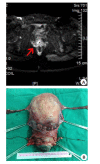[Pregnancy-preserving and maternal-fetal management in a patient with rare large cell neuroendocrine carcinoma of the uterine cervix]
- PMID: 33509747
- PMCID: PMC7867493
- DOI: 10.12122/j.issn.1673-4254.2021.01.01
[Pregnancy-preserving and maternal-fetal management in a patient with rare large cell neuroendocrine carcinoma of the uterine cervix]
Abstract
Objective: To explore the strategy of pregnancy-preserving and maternal- fetal management in patients with primary gynecologic neuroendocrine tumors (gNETs) during pregnancy.
Methods: We performed whole genome sequencing (WGS) for analyzing maternal and fetal somatic and germline single nucleotide variations (SNVs) and small insertions and deletions (InDels) for a 29-year-old pregnant woman diagnosed with stage IB2 large cell neuroendocrine carcinoma (LCNEC) and adenocarcinoma in the cervix. A systematic literature review was performed to explore the strategies for treatment of such rare histological type while maintaining pregnancy.
Results: Global case analysis of cervical NETs during pregnancy suggested that negative lymph node metastasis and an early FIGO stage were potentially associated with a good prognosis of the patients. In the case presented herein, a pregnancy-preserving strategy was adopted and favorable maternal-fetal outcomes were achieved after neoadjuvant chemotherapy, radical surgery and postoperative systemic chemotherapy. At 35+5 weeks, the fetus was delivered by caesarian section, and the patient has by now had a disease-free survival of 19 months postoperatively. WGS analysis revealed 6 missense somatic pathogenic mutations in two cancer tissues of the patient, and among them KARS and VEGFA were related with targeted therapy. Five pathogenic germline variants were detected in the patient and her son, suggesting the necessity of a long-term follow-up schedule including precise genetic counselling for both the mother and the child.
Conclusion: Although gNETs in pregnancy are rare and highly risky, pregnancy-preserving managements of gNETs can still be considered and favorable maternalfetal outcomes are possible with proper assessment of the clinical indications and implementation of multimodal treatments. Precise treatment and follow-up strategies based on the results of WGS for risk-reducing intervention of cancer recurrence or occurrence can potentially benefit the patient and the neonate.
Keywords: cancer predisposing genes; large cell neuroendocrine carcinoma; maternal-fetal management; pregnancy- preserving management; primary gynecologic neuroendocrine tumors.
Figures



Similar articles
-
[Clinical analysis of 32 cases with neuroendocrine carcinoma of the uterine cervix in early-stage disease].Zhonghua Fu Chan Ke Za Zhi. 2015 Mar;50(3):198-203. Zhonghua Fu Chan Ke Za Zhi. 2015. PMID: 26268410 Chinese.
-
Challenges in the management of neuroendocrine cervical cancer during pregnancy: A case report.Mol Clin Oncol. 2018 Nov;9(5):519-522. doi: 10.3892/mco.2018.1717. Epub 2018 Sep 13. Mol Clin Oncol. 2018. PMID: 30402233 Free PMC article.
-
Cervical neuroendocrine carcinoma in the third trimester: a rare case report and literature review.BMC Pregnancy Childbirth. 2023 Aug 10;23(1):571. doi: 10.1186/s12884-023-05900-2. BMC Pregnancy Childbirth. 2023. PMID: 37563542 Free PMC article. Review.
-
Cervical cancer complicating pregnancy: implications of laparoscopic lymphadenectomy.Gynecol Oncol. 2008 Mar;108(3):472-7. doi: 10.1016/j.ygyno.2007.12.006. Epub 2008 Jan 16. Gynecol Oncol. 2008. PMID: 18201752
-
Smear cytological features of large cell neuroendocrine carcinoma of the uterine cervix in pregnancy: A case report and review of the literature.Diagn Cytopathol. 2019 Feb;47(2):137-141. doi: 10.1002/dc.24106. Epub 2018 Nov 21. Diagn Cytopathol. 2019. PMID: 30461217 Review.
Cited by
-
Primary neuroendocrine tumor of the liver: A diagnostic dilemma in the management of liver mass in pregnancy.Radiol Case Rep. 2022 Apr 8;17(6):1996-2000. doi: 10.1016/j.radcr.2022.03.056. eCollection 2022 Jun. Radiol Case Rep. 2022. PMID: 35432666 Free PMC article.
References
-
- Gardner GJ, Reidy-Lagunes D, Gehrig PA. Neuroendocrine tumors of the gynecologic tract: A Society of Gynecologic Oncology (SGO) clinical document. Gynecol Oncol. 2011;122(1):190–8. doi: 10.1016/j.ygyno.2011.04.011. [Gardner GJ, Reidy-Lagunes D, Gehrig PA. Neuroendocrine tumors of the gynecologic tract: A Society of Gynecologic Oncology (SGO) clinical document[J]. Gynecol Oncol, 2011, 122(1): 190-8.] - DOI - PubMed
-
- Rouzbahman M, Clarke B. Neuroendocrine tumors of the gynecologic tract: select topics. Semin Diagn Pathol. 2013;30(3):224–33. doi: 10.1053/j.semdp.2013.06.007. [Rouzbahman M, Clarke B. Neuroendocrine tumors of the gynecologic tract: select topics[J]. Semin Diagn Pathol, 2013, 30(3): 224-33.] - DOI - PubMed
-
- Gibbs J, Mei S, Economos K, et al. Clinicopathologic features, incidence, and survival trends of gynecologic neuroendocrine tumors: a SEER database analysis. Am J Obstet Gynecol. 2019;221(1):53. e51–3.e56. [Gibbs J, Mei S, Economos K, et al. Clinicopathologic features, incidence, and survival trends of gynecologic neuroendocrine tumors: a SEER database analysis[J]. Am J Obstet Gynecol, 2019, 221(1): 53. e51-3.e56.] - PubMed
-
- Margolis B, Tergas AI, Chen L, et al. Natural history and outcome of neuroendocrine carcinoma of the cervix. Gynecol Oncol. 2016;141(2):247–54. doi: 10.1016/j.ygyno.2016.02.008. [Margolis B, Tergas AI, Chen L, et al. Natural history and outcome of neuroendocrine carcinoma of the cervix[J]. Gynecol Oncol, 2016, 141 (2): 247-54.] - DOI - PMC - PubMed
-
- Tempfer CB, Tischoff I, Dogan A, et al. Neuroendocrine carcinoma of the cervix: a systematic review of the literature. BMC Cancer. 2018;18(1):530. doi: 10.1186/s12885-018-4447-x. [Tempfer CB, Tischoff I, Dogan A, et al. Neuroendocrine carcinoma of the cervix: a systematic review of the literature[J]. BMC Cancer, 2018, 18(1): 530.] - DOI - PMC - PubMed
Publication types
MeSH terms
LinkOut - more resources
Full Text Sources
Medical
Miscellaneous
